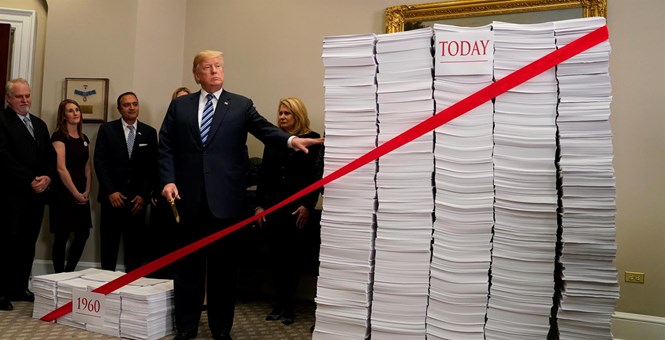Besides highlighting certain major rules burdening domestic energy production, the Department of the Interior’s “Energy Burdens” report lists several ways that ever-growing red tape has slowed down and added significantly to costs.
 The report stems from President Donald Trump’s efforts to get rid of unnecessary red tape. Overregulation turns a market competition into more of an obstacle course. Instead of a sprint toward the finish line, enterprisers have to tough it out through the sludge turning every step into a battle. Worse, such costs in time and money prevent marginal projects from even getting started.
The report stems from President Donald Trump’s efforts to get rid of unnecessary red tape. Overregulation turns a market competition into more of an obstacle course. Instead of a sprint toward the finish line, enterprisers have to tough it out through the sludge turning every step into a battle. Worse, such costs in time and money prevent marginal projects from even getting started.
The report documents many different ways the federal bureaucracy bogs down the path toward more domestic energy development:
- Delays fomented by “unnecessarily lengthy” reviews owing to numerous rules under the National Environment Policy Act of 1970. Those rules are now under review for revision or repeal.
- Uncertainty and inconsistency — as well as questionable constitutionality — of current compensatory mitigation policies. Those policies are now under review.
- “Systematic delays” in leasing and permitting. Zinke has formed a permit expediting committee to address various causes for delays, including updating software and creating regional teams to help streamline the process.
- Outdated, unnecessary, and ineffective rules under the Endangered Species Act of 1973 needlessly increasing project costs and furthering delays. Those rules are now under review.
 Those are prime examples of “deadweight loss — i.e., labor and capital employed in complying with government edicts and red tape, as opposed to being used for productive purposes.”
Those are prime examples of “deadweight loss — i.e., labor and capital employed in complying with government edicts and red tape, as opposed to being used for productive purposes.”
Readers interested in learning more about the president’s plans to eliminate unnecessary red tape and bureaucratic road-blocking of domestic energy production, take note. On November 9 the Heartland Institute is hosting the America First Energy Conference. It will feature national energy policy experts and industry leaders to discuss those issues and the future of energy policy under the new administration.

